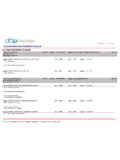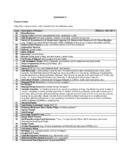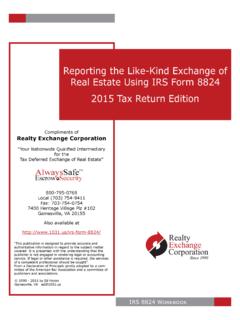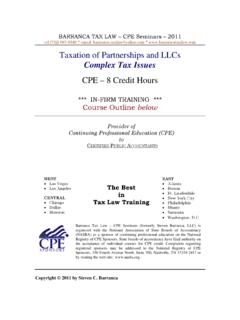Transcription of Understanding the Impact of Depreciation on Like …
1 1255 SW Prairie Trail Parkway Ankeny, IA 50023 Phone: (515) 244-6515 Fax: (515) 334-1174 FEA Understanding Impact of Depreciation on like - kind Exchanges (OVER) Understanding the Impact of Depreciation on like - kind Exchanges Owners and lessors of business-use assets such as equipment and fleets utilize IRC 1031 like - kind exchanges to preserve cash flow and prevent a forced downsizing of the business when assets are replaced. Companies are encouraged to replace and upgrade assets, stimulating purchases and sales of machinery, agricultural and construction equipment, cars, trucks, mining equipment, aircraft and railcars, because tax on the gain can be deferred. Section 1031 provides taxpayers with an incentive to replace idle and under-utilized assets with the modern, energy efficient and environmentally friendly equipment required to stay profitable in competitive markets. Depreciation and Timing Benefits When a depreciable asset is exchanged under IRC 1031, the taxable gain and Depreciation recapture is not recognized, but rather is rolled into the like - kind replacement asset.
2 Depreciation of the replacement asset is only allowable for any remaining tax basis (that was transferred from the old asset) and for value representing additional capital investment in the new asset. The total Depreciation expense allowed over the life of an asset that participates in an exchange is no greater than the Depreciation expense of an asset that does not participate in an exchange . For example, a company vehicle that is fully depreciated has a tax basis of $0 but a fair market value of $10,000. At the time of sale, Depreciation recapture (taxable income gain) is $10,000. If it was exchanged for a replacement vehicle at a cost of $25,0 00, that replacement vehicle would have a lowered tax basis, reduced by the exact amount of gain not recognized due to the exchange . The company would only be able to take Depreciation deductions equal to the $15,000 ($25,000 less $10,000 unrecognized gain) tax basis over the life of the new vehicle.
3 Essentially, 1031 provides nothing more than a cash flow timing benefit that is important to growing businesses. Section 1031 benefits the taxpayer by permitting immediate reinvestment of the entire amount of sale proceeds back into the business. Absent 1031, cash flow would be impaired because the taxpayer would need to reserve funds to pay Depreciation recapture tax, and would have to increase borrowing or use other savings to obtain additional funds necessary to purchase the replacement asset. Over the tax life of the replacement asset, the Treasury does not lose cash revenue due to an exchange because the taxpayer must forego future Depreciation deductions (equal to the unrecognized gain) on the replacement asset. This results in incrementally higher annual income to the taxpayer, taxed at ordinary income tax rates. The Treasury simply gives up only its timing benefit of being paid all taxes in one lump sum, in return for more robust economic activity generated from transferring this timing benefit to the taxpayer.
4 The following illustration demonstrates that over the tax life of a depreciable asset, the actual dollar Impact of a 1031 like - kind exchange to the Treasury is zero. FEA Understanding Impact of Depreciation on like - kind Exchanges Forgone Depreciation Delivers Neutral Cash-flow Impact to Treasury Assume that a heavy truck that was placed into service 5 years ago has a current fair market value of $25,000, and is being exchanged for a new heavy truck at a cost of $100,000. (Illustration assumes a 35% corporate tax rate). Since the old truck has a zero tax basis, the non-recognized recapture gain of $25,000 is transferred to the replacement truck, reducing the new truck's depreciable basis by $25,000. Note that forgone Depreciation over the 60 month Depreciation schedule equals the $25,000 gain deferred in the exchange . Section 1031 provides a timing benefit for tax payment, not a tax savings benefit. The benefit to the taxpayer is that current cash flow is preserved and available for reinvestment into the new truck.
5 Cash flow is not eroded by an immediate tax liability of $8,750, but rather the tax liability is paid incrementally, spread out over the Depreciation schedule through reduced Depreciation deductions. Relinquished Property Original Cost $ 83,000 Depreciation taken $ (83,000) Adjusted Tax Basis $ 0 Selling Price $ 25,000 Less: Adjusted Tax Basis $ 0 Tax Gain $ 25,000 Federal Tax Due if Sold $ (8,750) Federal Tax Due if Exchanged $ 0 Replacement Property Taxable Sale & Purchase (No exchange ) exchange Forgone Depreciation due to exchange Additional Federal Income Tax Paid Attributed to Forgone Depreciation Cost of New Truck $ 100,000 $ 100,000 Deferred Gain $ 0 $ (25,000) Adjusted Basis of New Truck $ 100,000 $ 75,000 Depreciation Year 1 (half year) $ 20,000 $ 15,000 $ (5,000) $ 1,750 Depreciation Year 2 $ 32,000 $ 24,000 $ (8,000) $ 2,800 Depreciation Year 3 $ 19,200 $ 14,400 $ (4,800) $ 1,680 Depreciation Year 4 $ 11,520 $ 8,640 $ (2,880)
6 $ 1,008 Depreciation Year 5 $ 11,520 $ 8,640 $ (2,880) $ 1,008 Depreciation Year 6 (half year) $ 5,760 $ 4,320 $ (1,440) $ 504 Total Allowable Depreciation $ 100,000 $ 75,000 $ (25,000) $ 8,750



